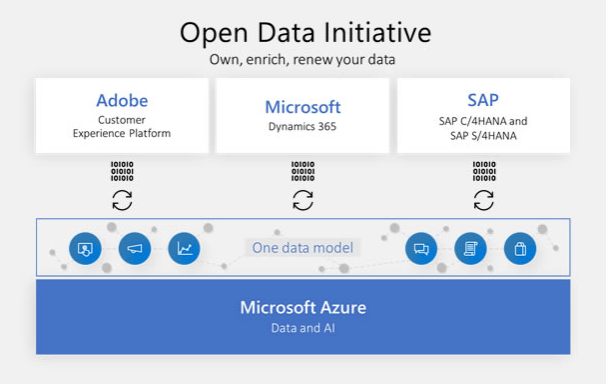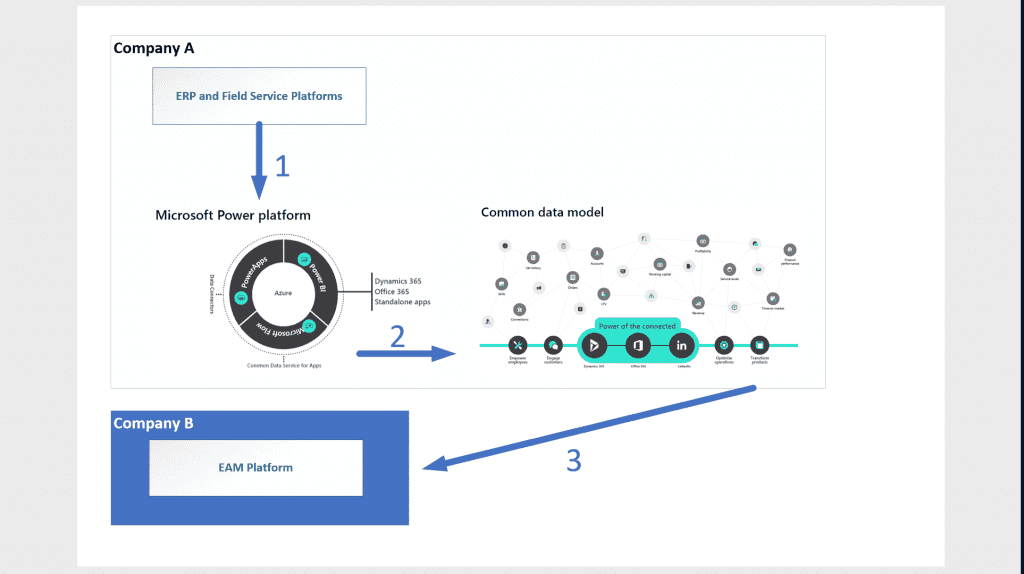This website uses cookies so that we can provide you with the best user experience possible. Cookie information is stored in your browser and performs functions such as recognising you when you return to our website and helping our team to understand which sections of the website you find most interesting and useful.
Microsoft’s Power Platform and (Your Business’) Common Data Model

Announcement at Ignite 2018
At the recent Microsoft Ignite 2018 Conference, an announcement was made by Microsoft, SAP, and Adobe named the “Open Data Initiative.” The purpose of this pre-announcement was to demonstrate to business organizations that their data is a critical asset and that it can and should be shared with your customers and partners. The image below provides a high level overview of what they are working to accomplish if you are using their software platforms. The key in the visual is the “one data model.”
What Is Possible Today
As we wait for more details about this capability, the capability exists today from Microsoft that allows you to bring together your data within your organization AND be able to share with your customers or partners. I will walk through an example demonstrating how both a manufacturer of a machine and its customer-owner can connect this common data through their digital process platforms using the Microsoft Power Platform’s Common Data Model.

Let’s start with an industrial equipment manufacturer (let’s call them Burback Industrial) that designs and manufacturers a machine named Product A001. Product A001 is a serialized machine that is sold to many of their customers and the customer then integrates this product into their own assembly line for production of their products. The example customer in this use case is Stewart Bakeries that has purchased Product A001. Burback Industrial tracks all the machines they sell to customer as a “customer asset” (or installed base) in a Dynamics 365 Field Service solution.
In addition, Stewart Bakeries has a number of machines of different manufacturers in their production facilities and they use an Equipment Asset Management (EAM) solution based on an Oracle ERP platform to manage the lifecycle of their assets. The EAM system helps them track the equipment’s serial number, scheduled maintenance, cost of ownership, responsibilities and related work.
Now that we have set the stage, let us get back to our common data topic—the common data here is the machine that was produced, its serial number, bill of material, etc. When the customer (Stewart Bakeries) receives the machine, they will duplicate this data into their EAM system. And when a service call is made, they will call Burback Industrial for a Field Service work order, which will start a new set of transactional data. In turn, Stewart Bakeries will create a Work Order in their EAM system to track the cost, work assignments, production line impacts.
By using the Microsoft Common Data Service as it is today, you now have the ability to easily share your common data with your customers and/or business partners.
Common data service step by step
- Take your ERP data for the machines you produce and store these details in the Microsoft Power Platform Common Data Model (Service)
- Share your common data with your customers or partners
- You can send (or push) machine data to customers that have purchased your products using Microsoft Flow
- Your customer can pull the data from your Common Data Service
- In turn, Stewart Bakeries would have their EAM system automatically populated with new machine data when they have purchased the product from Burback Industrial
- Transactional data service works the same way – Let’s say a new internal work order is opened in the EAM system at Stewart Bakeries; this could trigger the same data request to Burback Industrial’s Field Service system
Below is an example of a company having a Common Data Service in place so that they can share their “common data” with their customers.
- Company A builds a product (machine) within their ERP platform (Dynamics 365 Finance and Operations)
- Using the Microsoft Power Platform, the data is taken from ERP and placed into the Common Data Model
- Company B can then pulls the product information from the partner they just purchased from and places that data into their EAM platform (based on Oracle ERP)

What About Licensing?
All of this is possible today with the Microsoft Power Platform by leveraging the Common Data Service and Microsoft Flow. We are able to connect to both on premise and online platforms enabling a simple data share. Any company today that is running Dynamics 365 Finance and Operations or Customer Engagement is already licensed for Microsoft’s Power Platform Common Data Services. If you are running a non-Microsoft ERP, you are able to obtain the Microsoft Power Platform’s Common Data Service by subscribing to the Microsoft PowerApps Plan 2 solution.
Summary
Microsoft has provided a vision for “common data” and now you are able to enable a variety of methods in which to share your data and connect customers and their partners. Please contact us for additional information, a demonstration, or scoping of services to help your company integrate your data with your customers and partners with the best digital process solution from Microsoft using Dynamics 365 for Microsoft Power Platform.
For more information, be sure to check out the Microsoft Open Data Initiative press release.
This publication contains general information only and Sikich is not, by means of this publication, rendering accounting, business, financial, investment, legal, tax, or any other professional advice or services. This publication is not a substitute for such professional advice or services, nor should you use it as a basis for any decision, action or omission that may affect you or your business. Before making any decision, taking any action or omitting an action that may affect you or your business, you should consult a qualified professional advisor. In addition, this publication may contain certain content generated by an artificial intelligence (AI) language model. You acknowledge that Sikich shall not be responsible for any loss sustained by you or any person who relies on this publication.




